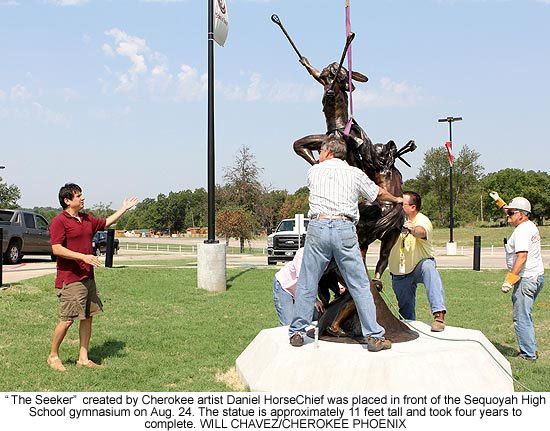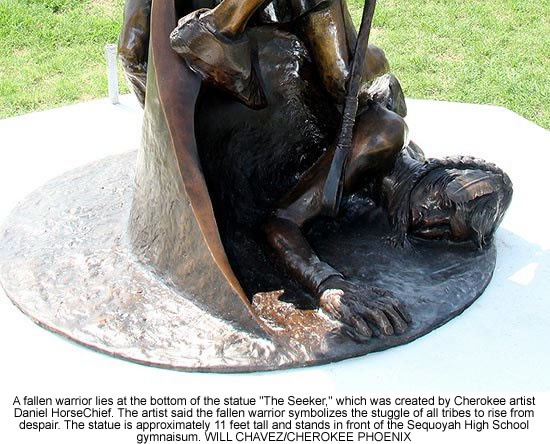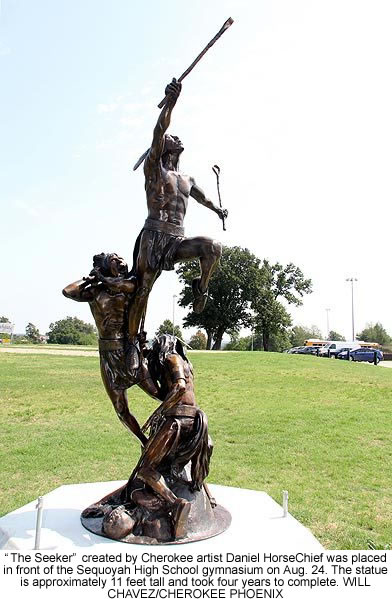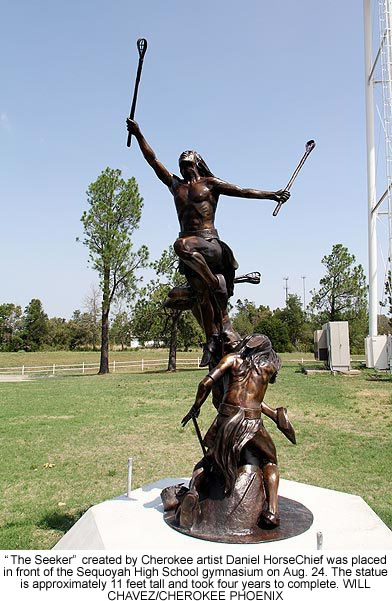 |
Canku Ota
|
 |
|
(Many Paths)
|
||
|
An Online Newsletter
Celebrating Native America
|
||
|
September
1, 2011 - Volume 9 Number 9
|
||
|
|
||
|
New HorseChief
Statue Installed at Sequoyah High School
|
||
|
by Will Chavez Cherokee
Phoenix
|
||
 TAHLEQUAH,
Okla. – A new bronze statue graces the grounds of Sequoyah
High School in front of the school's gymnasium. TAHLEQUAH,
Okla. – A new bronze statue graces the grounds of Sequoyah
High School in front of the school's gymnasium. Cherokee/Pawnee artist Daniel HorseChief created the approximately 11-foot tall statue titled "The Seeker." It was installed at the school on Aug. 24 without fanfare but an official dedication ceremony for the statue will be held later. HorseChief is also responsible for the nine-foot tall Sequoyah statues that sit on the campuses of NSU and SHS. He also recently created "Resurgence," a stickball statue that sits in the atrium of the Cherokee Heritage Center.
He added finding a place for the statue at SHS and an injury delayed him finishing "The Seeker." The statue is composed of four figures and each one symbolizes something different, he said. The person lying at the bottom of the statue looking worn and beaten could symbolize a person who didn't make it to Indian Territory during the removal of tribes from the southeastern United States or someone who has been defeated during in life, HorseChief explained.
"He could represent the more demanding obstacles, the last obstacles that you have to overcome," he said. The third figure also represents anger and each figure represents an emotion, he said. "The main (top) figure, he represents victory or triumph…he represents literally attaining your goal," he said. "I wanted this for all Native people. We all have similarities. We all have similarities, and we all have personal obstacles and friends that we've lost, love ones, so I wanted to show that." The struggles represented could be drug and alcohol abuse, mental and physical struggles and obstacles created by society, HorseChief explained. "There are so many things they could represent," he said. The statue was originally meant for the gymnasium's atrium, which HorseChief said called for a scaled down version of the statue. Ultimately, he rejected the four-foot statue because he believed it was too small to truly represent his vision.
HorseChief also had a hand in determining how the base would look. It is a seven-sided base to represent the Cherokee Nation's seven clans. The base will have lights to illuminate the figure at night, and HorseChief has asked the CN to landscape the area around the statue and plant pine trees. On a personal note, HorseChief said the statue could also represent his personal struggles before he became a full-time artist. As a comparison to where he life was while he was in college compared to his life now as a successful artist, he said in college he was voted by his friends as most likely to die first among his friends. "With God's help it's turned completely around, and I have a great family. I love my people—all of my people. It's only with his (God's) help that I'm here standing," he said. "It's been a learning process, and I've been corrected a lot, but I'm glad. I just feel so fortunate, it's like a dream, to be able to get a chance like this." |
|
|
||
|
|
||
| Canku Ota is a free Newsletter celebrating Native America, its traditions and accomplishments . We do not provide subscriber or visitor names to anyone. Some articles presented in Canku Ota may contain copyright material. We have received appropriate permissions for republishing any articles. Material appearing here is distributed without profit or monetary gain to those who have expressed an interest. This is in accordance with Title 17 U.S.C. Section 107. | ||
|
Canku Ota is a copyright ©
2000, 2001, 2002, 2003, 2004, 2005, 2006, 2007, 2008, 2009, 2010,
2011 of Vicki Barry and Paul Barry.
|
||
 |
 |
|
|
The "Canku
Ota - A Newsletter Celebrating Native America" web site and
its design is the
|
||
|
Copyright ©
1999, 2000, 2001, 2002, 2003, 2004, 2005,
2006, 2007, 2008, 2009, 2010, 2011
of Paul C. Barry.
|
||
|
All Rights Reserved.
|
||
 "This
one actually came before all of those, even before the Sequoyah
piece (2009). It was actually my first large commission, but it's
been put on hold off and on. It's been four years coming," he said.
"This
one actually came before all of those, even before the Sequoyah
piece (2009). It was actually my first large commission, but it's
been put on hold off and on. It's been four years coming," he said. The
second figure from the bottom represent a person's failures and
them fighting through their obstacles while the third figure is
"actively and aggressively" trying to block the progress of the
warrior who is fighting to survive or overcome obstacles.
The
second figure from the bottom represent a person's failures and
them fighting through their obstacles while the third figure is
"actively and aggressively" trying to block the progress of the
warrior who is fighting to survive or overcome obstacles.  "It
looked too small, and I'm glad it worked out that way because moving
outside makes it stand out more," he said.
"It
looked too small, and I'm glad it worked out that way because moving
outside makes it stand out more," he said.